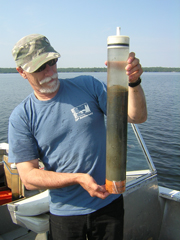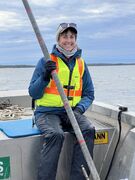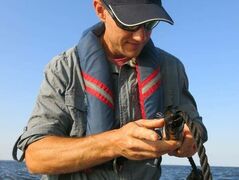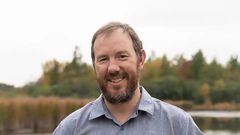 Bev Clark examines sediment core from Lake of the Woods.Summer is a busy season for research scientists who study our watershed. Although high tech tools like satellite-based remote sensing can provide some very valuable types of information, getting out in the field to take physical and chemical measurements of water, sediments and the aquatic ecosystem is still a crucial way that scientists gather data and come to understand our watershed.
Bev Clark examines sediment core from Lake of the Woods.Summer is a busy season for research scientists who study our watershed. Although high tech tools like satellite-based remote sensing can provide some very valuable types of information, getting out in the field to take physical and chemical measurements of water, sediments and the aquatic ecosystem is still a crucial way that scientists gather data and come to understand our watershed.
Aside from research that's specifically focused on winter conditions, the field season for doing on-the-ground, in-lake studies typically runs from the time the ice retreats off our lakes and rivers in the spring, until it freezes over again in the fall. During these ice-free months, scientists get out in their boats and boots to measure temperature, chemisty, clarity and other properties of water. They look at changes in the biological ecosystem, tracking the movement of invasive species of concern, or measuring how native plants and animals are responding to changes in the environment.
In any given field season, there are dozens of scientists active in the Rainy-Lake of the Woods watershed, from the headwaters, through the boundary waters in Voyageurs National Park, and on into Rainy River and Lake of the Woods in Minnesota and Canada. These scientists are affiliated with universities and colleges, state, provincial, federal and Indigenous government agencies, and with non-profits and think tanks.
Every year, we showcase a wide range of contemporary watershed science during the annual International Rainy - Lake of the Woods Watershed Forum, which takes place in International Falls, MN in early March. The Forum is open to all. You can learn more and find out how to register (and submit an abstract for a talk or poster) by visiting the Forum webpage.
In this webinar, we're going to present a sample of the type of information you'd hear at the Forum. We'll be joined by three research scientists who have been actively working in the field this summer and fall.
Anna Baker, a hydrologist with the United States Geological Survey, will tell us about her work studying how stream sediments hold, carry, and release nutrients like phosphorus. Her work helps us to better understand how these nutrients, which can cause algae to flourish, are managed in nature. When do they become free-floating in the water column and therefore biologically available, and when are they bound up in ways that make them unavailable as building blocks for algae and other plants?
We'll also hear from Shane Bowe, the Director of the Red Lake Band's Water Resources Program, and Dr. Adam Heathcote of the Science Museum of Minnesota's St. Croix Watershed Research Station, who work collaboratively on a number of projects of interest to the Red Lake Band. These include the study of algal toxins in the St. Crox watershed and also understanding the biology and ecology of wild rice in the Tribe's territory in the Northwest Angle of Lake of the Woods.
We hope you'll join us to get a first-hand glimpse into some of the science that's happening in our backyard in 2023. As always, please come prepared to listen, learn and ask questions!
About the Presenters
 Anna Baker is a hydrologist with the USGS Upper Midwest Water Science Center and has been working in Minnesota since 2017. She obtained her Masters in Water Resources Science at the University of Minnesota in 2018 where her research focused on examining the role of sediment in driving phosphorus dynamics in the Le Sueur River basin. She applies her expertise in sediment chemistry and surface water quality to studies of sediment source and sediment phosphorus binding dynamics in the Rainy – Lake of the Woods basin and tributaries to south-shore Lake Superior.
Anna Baker is a hydrologist with the USGS Upper Midwest Water Science Center and has been working in Minnesota since 2017. She obtained her Masters in Water Resources Science at the University of Minnesota in 2018 where her research focused on examining the role of sediment in driving phosphorus dynamics in the Le Sueur River basin. She applies her expertise in sediment chemistry and surface water quality to studies of sediment source and sediment phosphorus binding dynamics in the Rainy – Lake of the Woods basin and tributaries to south-shore Lake Superior.
 Shane Bowe is the Director of the Red Lake Band Water Resources Program where he oversees the management of water resources including lakes, streams, and wetlands. Mr. Bowe and his staff have been collecting water quality data from the Northwest Angle of Lake of the Woods for over a decade. Since 2016, Mr. Bowe has represented the Red Lake Band of Chippewa Indians on the International Rainy Lake of the Woods Watershed Board, where he is also a member on the Aquatic Ecosystem Health Committee of the Watershed Board. Mr. Bowe is an aquatic biologist and completed his Bachelor of Science at Bemidji State University in 2004 and his Master of Science in Biology at Bemidji State University in 2010.
Shane Bowe is the Director of the Red Lake Band Water Resources Program where he oversees the management of water resources including lakes, streams, and wetlands. Mr. Bowe and his staff have been collecting water quality data from the Northwest Angle of Lake of the Woods for over a decade. Since 2016, Mr. Bowe has represented the Red Lake Band of Chippewa Indians on the International Rainy Lake of the Woods Watershed Board, where he is also a member on the Aquatic Ecosystem Health Committee of the Watershed Board. Mr. Bowe is an aquatic biologist and completed his Bachelor of Science at Bemidji State University in 2004 and his Master of Science in Biology at Bemidji State University in 2010.
 Dr. Adam Heathcote is the Director of the Department of Water and Climate Change at the Science Museum of Minnesota’s St. Croix Watershed Research Station.
Dr. Adam Heathcote is the Director of the Department of Water and Climate Change at the Science Museum of Minnesota’s St. Croix Watershed Research Station.
Dr Heathcote is an ecosystem ecologist whose work focuses on the interactions between lake biogeochemistry and plankton ecology. His research involves quantifying how humans impact the cycling of nutrients (carbon, nitrogen, and phosphorus) in lakes and how these changes are reflected in terms of lake productivity and algal community structure. On Lake of the Woods, his work in 2023 focuses on extending the long-running partnership for water quality monitoring in the southern basin between the Science Museum of Minnesota, the Minnesota Pollution Control Agency, and the Red Lake Department of Natural Resources. Dr. Heathcote holds a PhD from Iowa State University (2013).
Note that the session will be recorded for rebroadcast to the LOWWSF website.
